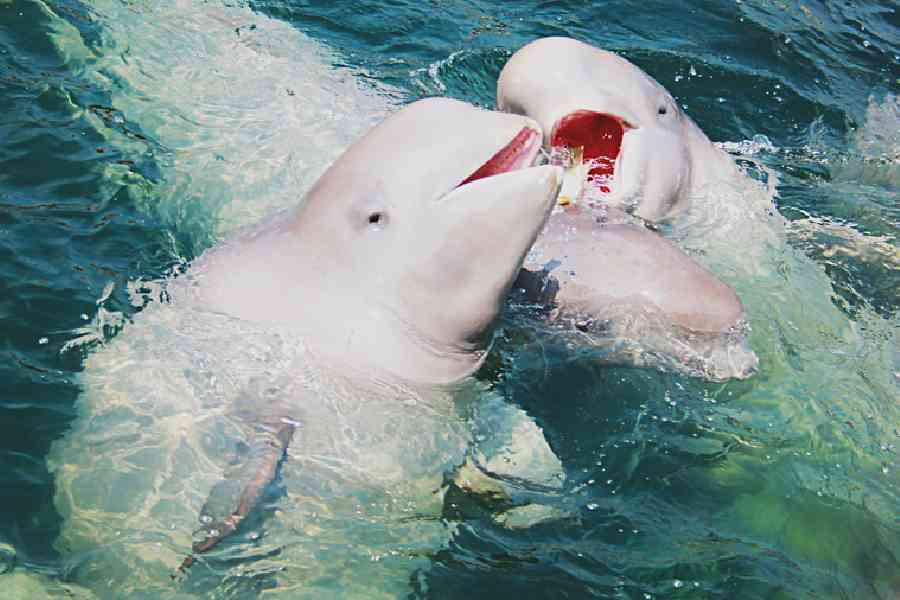It was a whale of an evacuation. Actually, two.
In what experts said was the most complex marine mammal rescue ever undertaken, the pair of beluga whales were extricated from an aquarium in the battered city of Kharkiv in eastern Ukraine and transported to Europe’s largest aquarium in Valencia, Spain, on Wednesday morning.
As Russian aerial bombardments of Kharkiv, Ukraine’s second-largest city, have intensified, the evacuation of Plombir, a 15-year-old male, and Miranda, a 14-year-old female, came just in time, marine mammal experts said.
“If they had continued in Kharkiv, their chances of survival would have been very slim,” said Daniel Garcia-Párraga, director of zoological operations at Oceanogràfic de Valencia, who helped lead the rescue.
Belugas, whose natural habitat is the Arctic, need cold water to survive. The devastation of the power grid in Kharkiv meant that the aquarium there had to rely on generator power, making it challenging to keep the waters cooled.
At the same time, the whales’ diets were halved recently amid shortages of the 132 pounds of squid, herring, mackerel and other fresh fish the pair needed daily, Dr Garcia-Párraga said. Ukrainian caregivers were even considering using discarded fish from restaurants and markets.
And in recent weeks, bombs exploded close enough to ripple the waters of their home at the NEMO Dolphinarium. As the conditions grew more precarious, the Ukrainians decided the whales required evacuation.
Moving marine mammals can be risky in the best of circumstances. Transporting sick or stressed animals ratchets up the difficulty.
“You’d like to make sure that anybody that gets transported is as healthy as possible,” said Michael Walsh, a veterinarian who leads the marine animal rescue programme at the University of Florida but was not involved in the operation.
In emergencies, he said: “You may not have as much of a choice.”
Dan Ashe, head of the Association of Zoos and Aquariums and the former head of the US Fish and Wildlife Service, said it took “the world’s most elite team of marine mammal experts” to achieve what he said was “likely the most complex marine mammal rescue ever undertaken”.
Specialists from Oceanogràfic de Valencia, Georgia Aquarium in Atlanta and SeaWorld all assisted the Ukrainians in the operation, a 36-hour journey over more than 1,900 miles that started on Monday evening and was completed just before dawn on Wednesday.
Dennis Christen, senior director of animal well-being and behaviour at Georgia Aquarium, who met the whales after they had crossed from Ukraine into Moldova, said in an interview that “the complexities of this evacuation were immense” and that rescuers had worked for weeks to prepare.
Christen and Dr Garcia-Párraga both said the rescue would have been impossible if one of the world’s leading beluga whale experts had not lived in Kharkiv.
That expert, Olga Shpak, abandoned her research the day Russia invaded and moved to Kharkiv to help in the war, working with Assist Ukraine, a charity assisting soldiers and civilians at the front.
Reached by phone as she was driving across eastern Ukraine, Shpak said she was aware of the whales’ plight in Kharkiv when the war had started, but with Russian forces pressing against the city, the evacuation was not feasible.
After the Russians were driven from the region in the fall of 2022 and the situation stabilised, the worries about the animals faded.
As conditions worsened in recent months and evacuation plans took shape, Dr Garcia-Párraga reached out to Shpak. The two first met at a conference on beluga whales in Valencia in 2007 but had lost touch after the invasion. Once reconnected, Shpak became the central contact between the Ukrainians and the international experts.
Christen said they would pepper her day and night with a thousand questions and she fielded them all.
The issues started with Ukraine’s transport crates, which were not designed for belugas and were too small. The Ukrainians decided that each time a crate with a whale was lifted, they would drain the water rather than risk breaking it.
“The Ukrainian team did a great job moving the animals from Kharkiv to Odesa,” Dr Garcia-Párraga said.
A member of the Oceanogràfic team met the truck carrying the crates in Odesa, where a critical inspection took place.
Once the truck crossed the border to Moldova, there would be no turning back. So if there was any issue with the crates or the health of the whales, they needed to spot it in Odesa. The team gave the green light and the whales were back on the road.
In Moldova, Dr Garcia-Párraga and Christen hopped on the truck for the trip to the airport. Because the Moldovan airport lacked the heavy-lifting cranes needed to move the whales, the rescuers chartered a specific cargo plane equipped with an interior crane.
Paperwork complications and the Italian Prime Minister’s simultaneous transit through the airport all added precious hours to the trip. As the clock ticked, the team needed to constantly monitor the whales and keep the water in the tanks between 22 and 24 degrees Celsius.
They finally reached Valencia before dawn, and by 6:30 a.m. they were in their new home.
New York Times News Service










